Biological Activity of the Salvia officinalis L. (Lamiaceae) Essential Oil on Varroa destructor Infested Honeybees
Abstract
1. Introduction
2. Results
2.1. Estimation of the Initial Infestation Rate in Hives by the Varroa Mite Destructor before Treatment
2.2. Estimation of the Infestation Rate in the Different Hives after Treatment with the Essential Oil of Sage Salvia officinalis
2.2.1. Comparison between the Effect of the Different Doses of EO in the Batches 01, 02, 03, Treated with the Chemical Treatment
2.2.2. Statistical Analysis of the Results: Variance Analysis
3. Discussion
4. Materials and Methods
4.1. Plant Material
4.2. Animal Material
4.3. Method of Extraction of Essential Oil HS from Sage
- R: percentage of the essential oil.
- V: volume obtained in essential oil.
- M: weight of the dry material (g).
- Preparation of the dilutions
- Preparation of 03 dilutions of essential oils to be tested by diluting:
- D1: 0.5 mL of essential oils in 100 mL of twin.
- D2: 1.5 mL of essential oils in 100 mL of twin.
- D3: 02 mL of essential oils in 100 mL of twin.
4.4. Method for Estimating the Initial Infestation Rate of Different Hives
4.5. Method for Estimating the Number of Bees in a Colony
4.6. Method for Calculating Colony Infestation Rate
- C: corresponds to the number of varroa estimated in a colony.
- P: corresponds to the number of bees estimated in a colony [15].
4.7. Method for Estimating the Infestation Rate of Different Hives after Treatment
4.8. Method for Calculating Colony Infestation Rate
- C: corresponds to the number of varroa estimated in the colony before treatment.
- M: corresponds to the number of varroa that fell after the treatment.
- P: corresponds to the number of bees estimated in a colony [15].
4.9. Method for Studying the Phytotoxic Activity of Sage
- The essential oil of a 5% dose: more than 30 min to notice the beginning of the death of some bees.
- The essential oil of a 15% dose: 14.34 min to notice the death of almost all the bees.
- The essential oil of a 20% dose: 6.25 min to notice the death of all the bees.
5. Conclusions
Author Contributions
Funding
Acknowledgments
Conflicts of Interest
References
- Clement, H. L’abeille Sentinelle de L’environnement; Editions Alternatives: Paris, France, 2009. [Google Scholar]
- Garcia-Fernandez, P.; Rodriguez, R.B.; Orantes-Bermejo, F.J. Influence du climat sur le développement de la population de Varroa jacobsoni Oud. dans des colonies d’Apis mellifera iberica (Goetze) dans le sud de l’Espagne. Apidologie 1995, 26, 371–380. [Google Scholar] [CrossRef]
- Ellis, J.D.; Zettel Nalen, C.M. Varroa Mite, Varroa destructor Anderson and Trueman (Arachnida: Acari: Varroidae); EENY-473; IFAS Extention, University of Florida: Gainesville, FL, USA, 2010. [Google Scholar]
- Colin, M.E. La varroase. Rev. Sci. Tech. 1982, 1, 1177–1189. [Google Scholar] [CrossRef]
- Belaid, M.; Doumandji, S. Effet du varroa distructor sur la morphométrie allaire et sur les composants du systhème immunitaire de l’abeille ouvrière Apis mellifera intermisa. Leban. Sci. J. 2010, 11, 45–53. [Google Scholar]
- Teffahi, M.; Belguendouz, R. Etude de L’activité Acaricide de L’origan (Origanum glandulosum) et du Romarin (Rosmarinus officinalis) Sur le Parasite (Varroa jacopsoni) de L’abeille. Master’s Thesis, Blida University, Blida, Algeria, 2014. [Google Scholar]
- Ghorbani, A.; Esmaeilizadeh, M. Pharmacological properties of Salvia officinalis and its components. J. Tradit. Complement. Med. 2017, 7, 433–440. [Google Scholar] [CrossRef] [PubMed]
- Colin, M.E. A method for characterizing the biological activity of Essential oils against Varroa jacobsoni. In New Perspectives on Varroa A Matheson; IBRA: Cardiff, UK, 1994. [Google Scholar]
- Badiee, P.; Nasirzadeh, A.R.; Motaffaf, M. Comparison of Salvia officinalis L. essential oil and antifungal agents against candida species. J. Pharm. Technol. Drug. Res. 2012. [Google Scholar] [CrossRef]
- Hayouni, E.A.; Chraief, I.; Abedrabba, M. Tunisian Salvia officinalis L. and Schinusmolle L. essential oils: their chemical compositions and their preservative effects against Salmonella inoculated in minced beef meat. Int. J. Food Microbiol. 2008, 125, 242–251. [Google Scholar] [CrossRef] [PubMed]
- Langer, R.; Mechtler, C.; Jurenitsch, J. Composition of the essential oils of commercial samples of Salvia officinalis L. and S. fruticosa Miller: A comparison of oils obtained by extraction and steam distillation. Phytochem. Anal. 1996, 7, 289–293. [Google Scholar] [CrossRef]
- Mills, S.; Bone, K. The Essential Guide to Herbal Safety; Elsevier: Louis, MO, USA, 2005. [Google Scholar]
- Veličković, D.T.; Ranđelović, N.V.; Ristić, M.S.; Veličković, A.S.; Šmelcerović, A.A. Chemical constituents and antimicrobial activity of the ethanol extracts obtained from the flower, leaf and stem of Salvia officinalis L. J. Serb. Chem. Soc. 2003, 68, 17–24. [Google Scholar] [CrossRef]
- Russo, A.; Formisano, C.; Rigano, D. Chemical composition and anticancer activity of essential oils of Mediterranean sage (Salvia officinalis L.) grown in different environmental conditions. Food Chem. Toxicol. 2013, 55, 42–47. [Google Scholar] [CrossRef] [PubMed]
- Robaux, P. Varroa et Varroatose; Opida: Echauffour, France, 1986. [Google Scholar]
- Pettis, J.S. A scientific note on Varroa destructor resistance to coumaphos in the United States. Apidologie 2004, 35, 91–92. [Google Scholar] [CrossRef]
- Pettis, J.S.; Lichtenberg, E.M.; Andree, M.; Stitzinger, J.; Rose, R.; Vanengelsdorp, D. Crop pollination exposes honey bees to pesticides which alters their susceptibility to the gut pathogen Nosema ceranae. PLoS ONE 2013, 8. [Google Scholar] [CrossRef] [PubMed]
- Lindberg, C.M.; Melathopoulos, A.P.; Winston, M.L. Laboratory evaluation of miticides to control Varroa jacobsoni (Acari: Varroidae), a honey bee (Hymenoptera: Apidae) parasite. J. Econ. Entomol. 2000, 93, 189–198. [Google Scholar] [CrossRef] [PubMed]
- Auger, J.; Thibout, E. Susbtances soufrées des Allium et des Crucifères et leurs potentialités phytosanitaires. In Biopesticides D’origine Végétale; Regnault-Roger, C., Philogène, B.J.R., Vincent, C., Eds.; Lavoisier, Tec & Doc: Paris, France, 2002. [Google Scholar]
- Yakhlef, G. Etude de L’activité Biologique des Extraits de Feuilles de Thymus vulgaris L. et Laurius nobilis L. Master’s Thesis, EL Hadj Lakhdar—Batna University, Batna, Algeria, 2010. [Google Scholar]
- Ghomari, F.N.; Kouache, B.; Arous, A.; Cherchali, S. Effet de traitement par fumigation du thym (Thymus vulgaris) sur le Varroa destructor agent de la varroase des abeilles. Nat. Technol. 2014, 10, 34–38. [Google Scholar]
- Giovenazzol, P.; Marceau, J.; Dube, S. Essais préliminaires sur le traitement de colonies d’abeilles Apis mellifera infestées par le parasite Varroa jacobsoni en chambre d’hivernage. L’abeille 1999, 19, 5. Available online: www.agrireseau.net/apiculture/Documents/essais_traitement_acariose.pdf (accessed on 5 June 2018).
- Moussaoui, K.; Ahmed Hedjala, O.; Zitouni, G.; Djazouli, Z. Estimation de la toxicité des d’huiles essentielles formulées de thym et d’eucalyptus et d’un produit de synthèse sur le parasite de l’abeille tellienne varroa destructor (arachnida, varroidae). Agrobiologie 2014, 4, 17–26. [Google Scholar]
- Branislava, S.; Lakušić, C.; Mihailo, S.; Ristić, A.; Violeta, N.; Slavkovska Danilo, L.; Stojanović, C.; Dmitar, V.; Lakušić, C. Variations in essential oil yields and compositions of Salvia officinalis (Lamiaceae) at different developmental stages. Bot. Serb. 2013, 37, 127–139. [Google Scholar]
- European Pharmacopoeia Commission. Ph. Eur. 6.0. Council of Europe; European Pharmacopoeia Commission: Strasbourg, France, 2007. [Google Scholar]
- Bruneton, J. Pharmacognosie, Phytochimie, Plantes Médicinales, 3rd ed.; Technique et DocumentationLavoisier: Paris, France, 1999. [Google Scholar]
- Berkani, M.L. Comparaison de Deux Types de Ruches: Dadant et Langstroth Dans les Littoral Est et Algérois. Master’s Thesis, High school of Agronomy, El Harrach, Algeria, 1985. [Google Scholar]
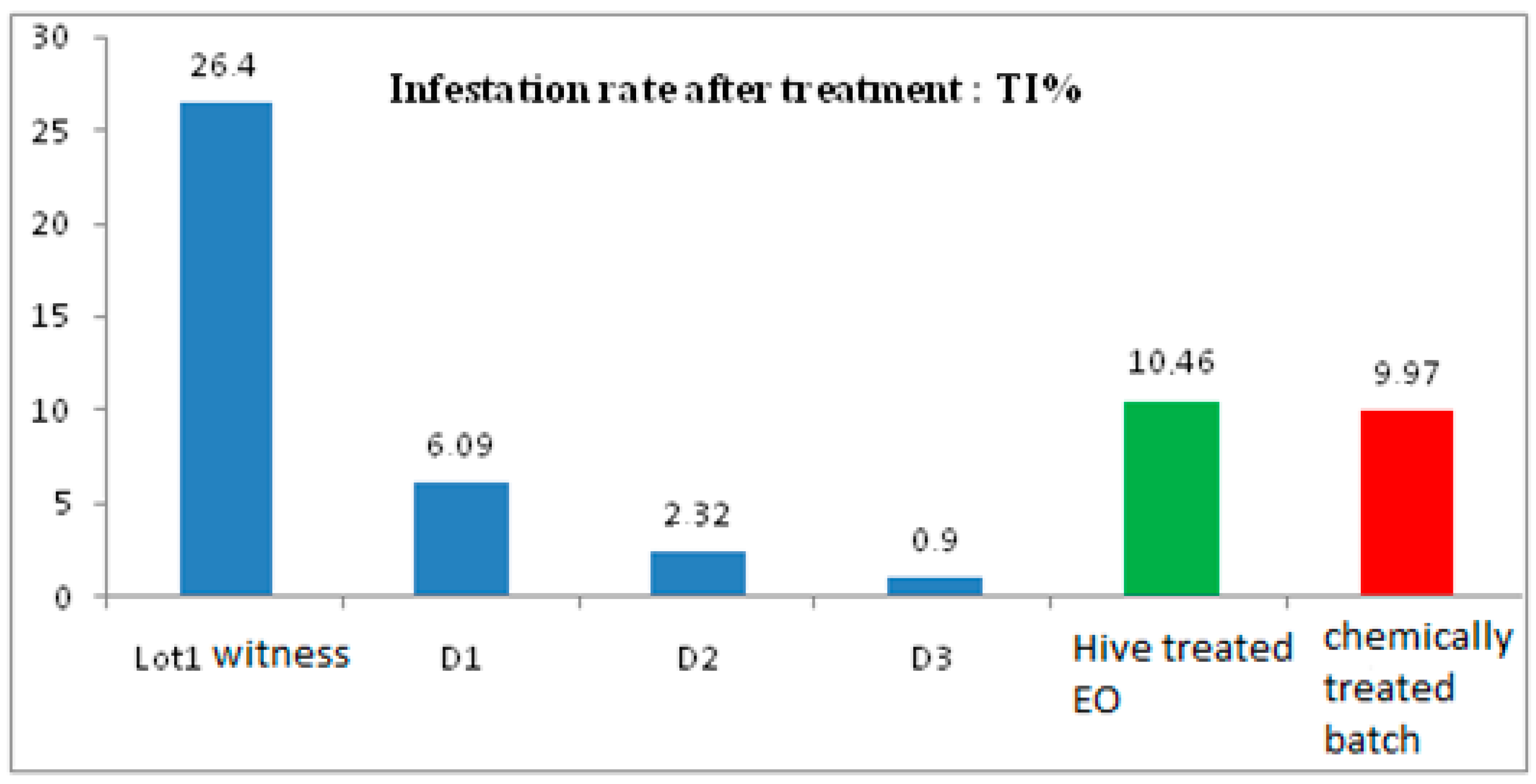
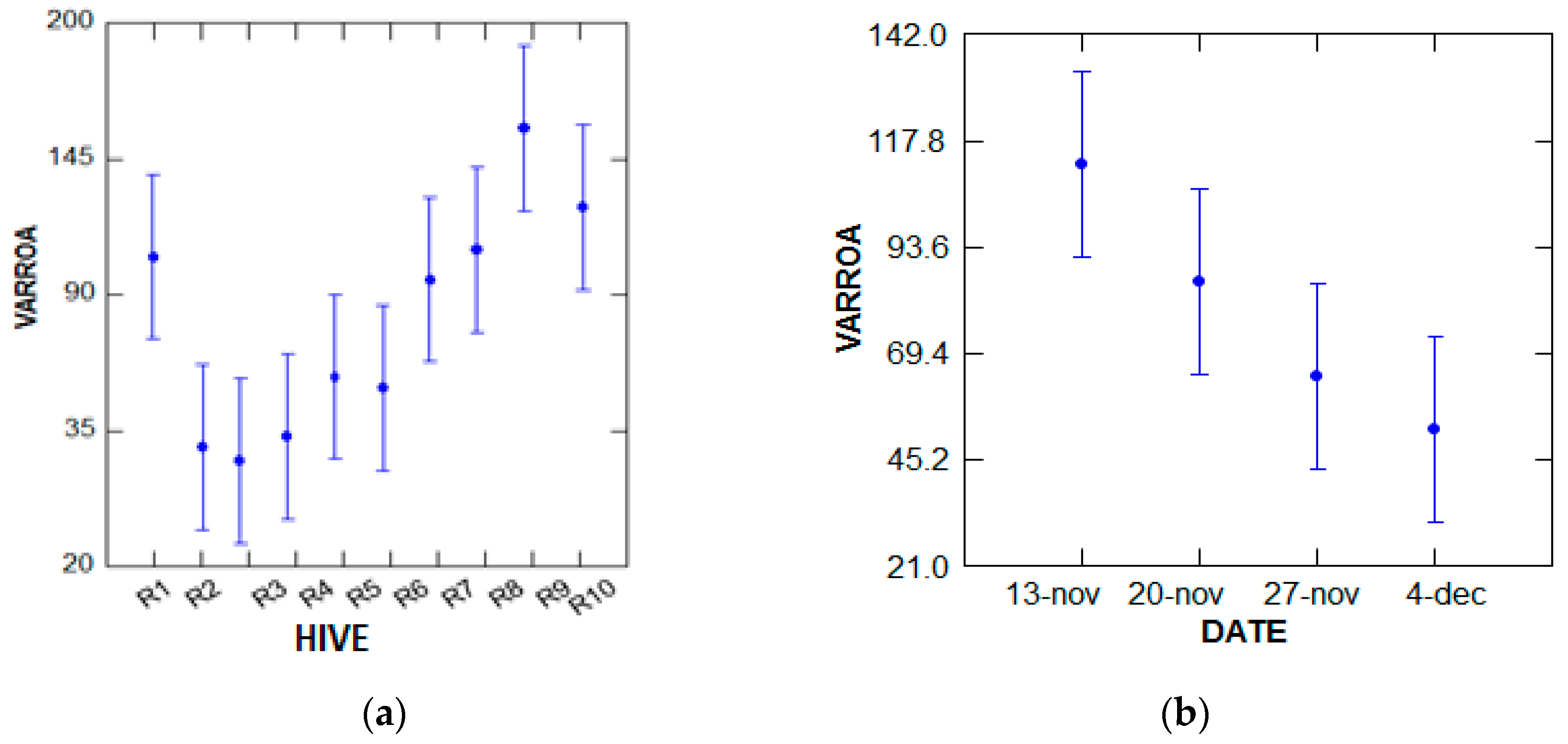
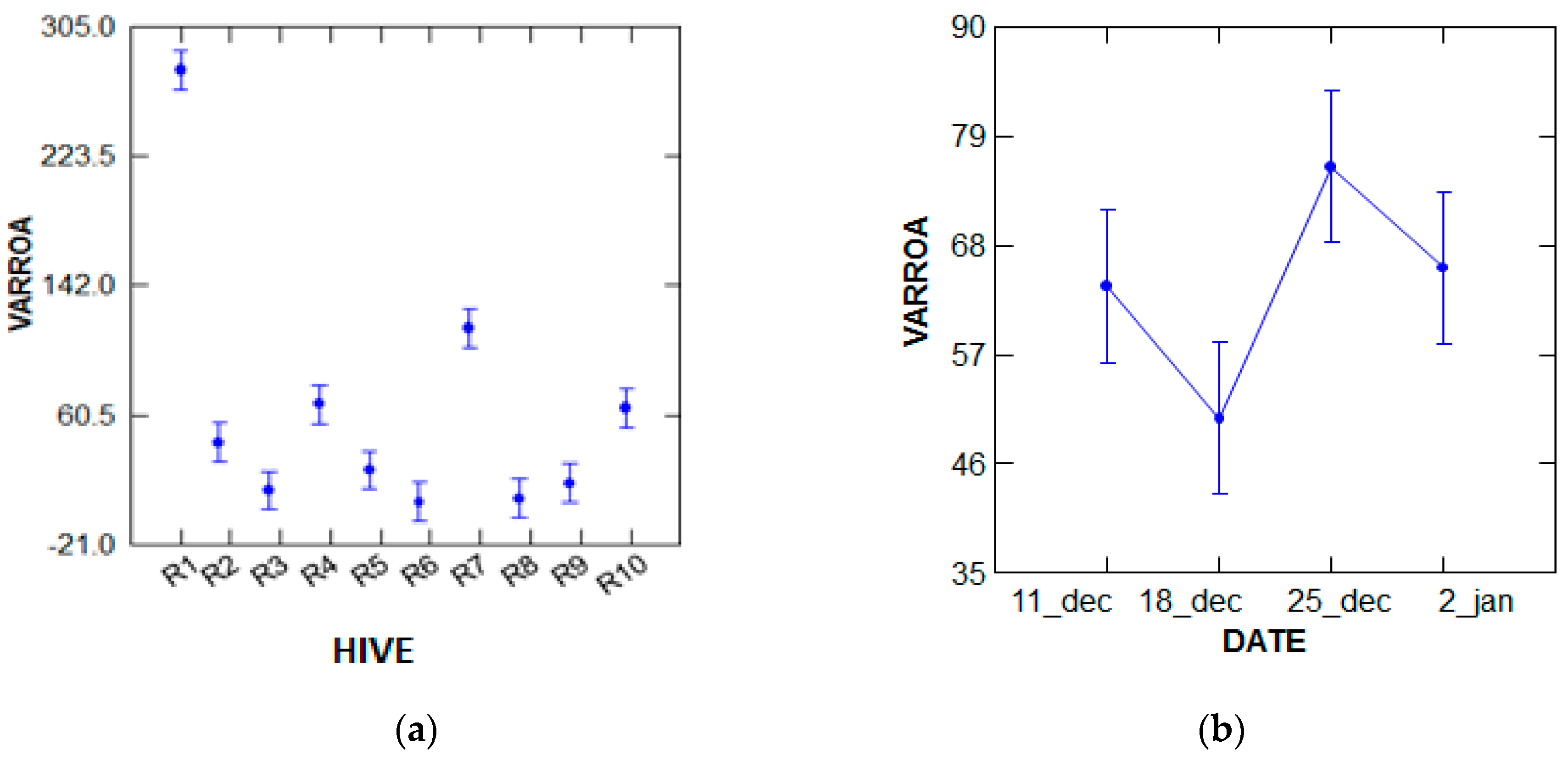
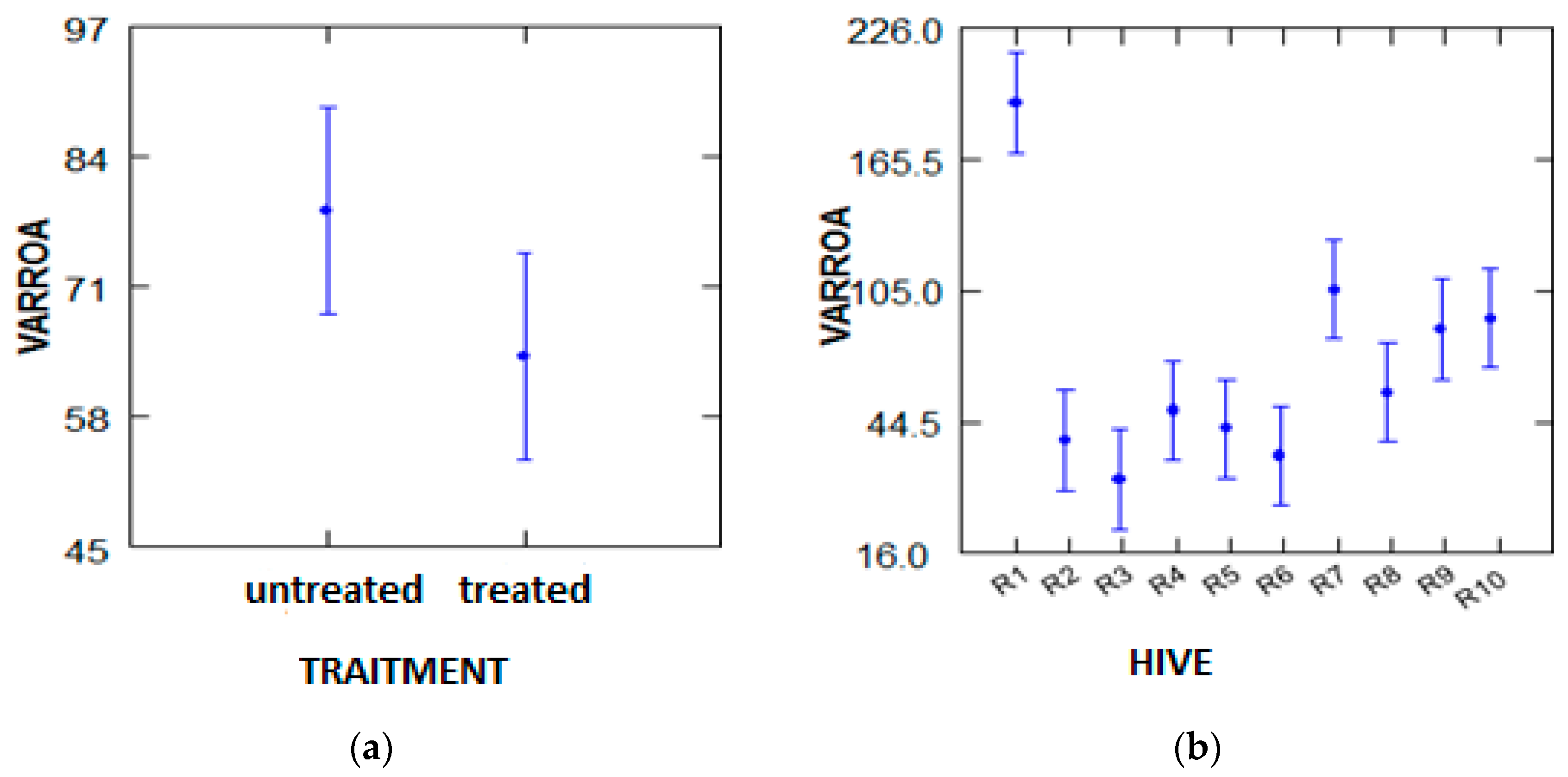

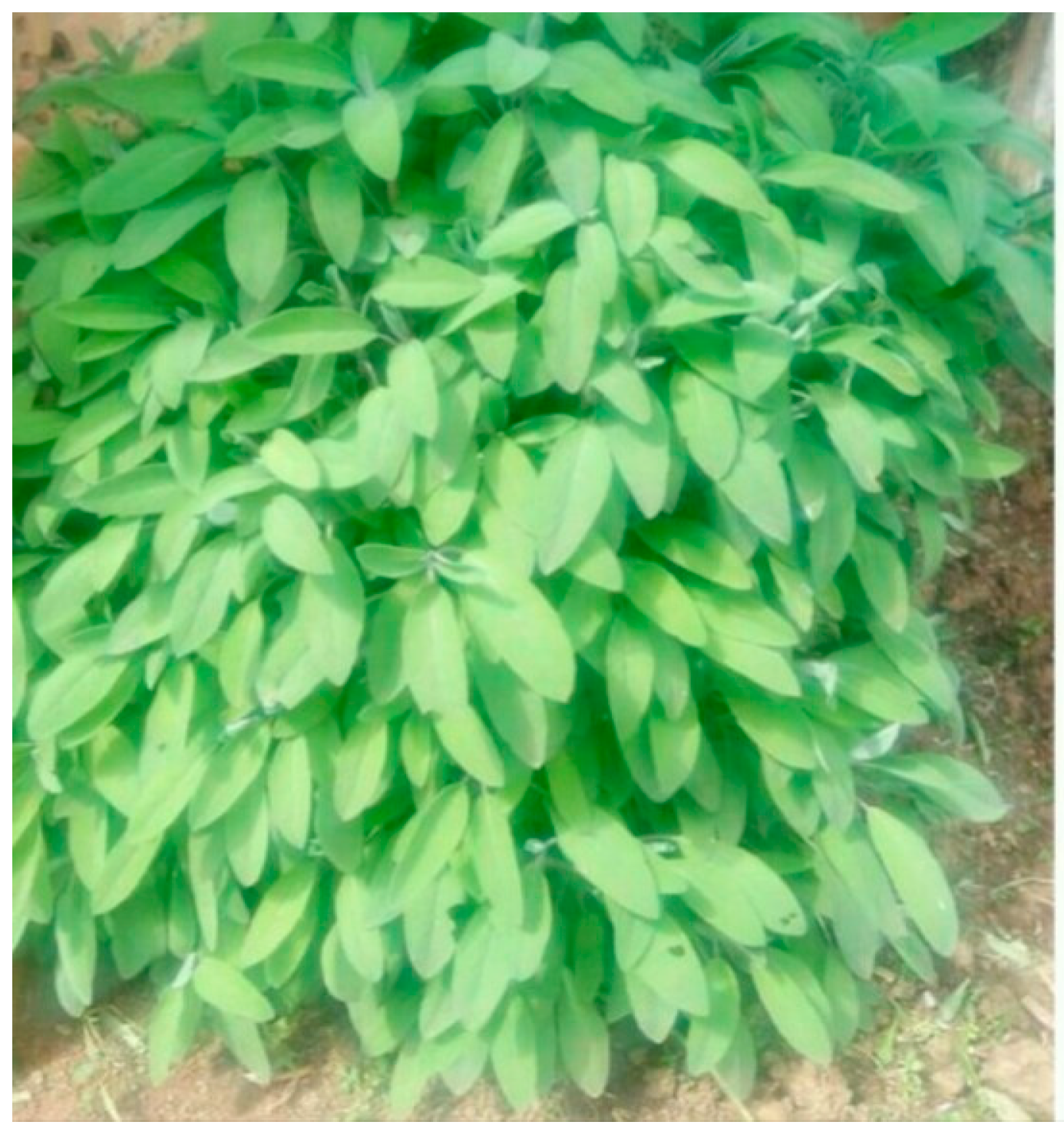
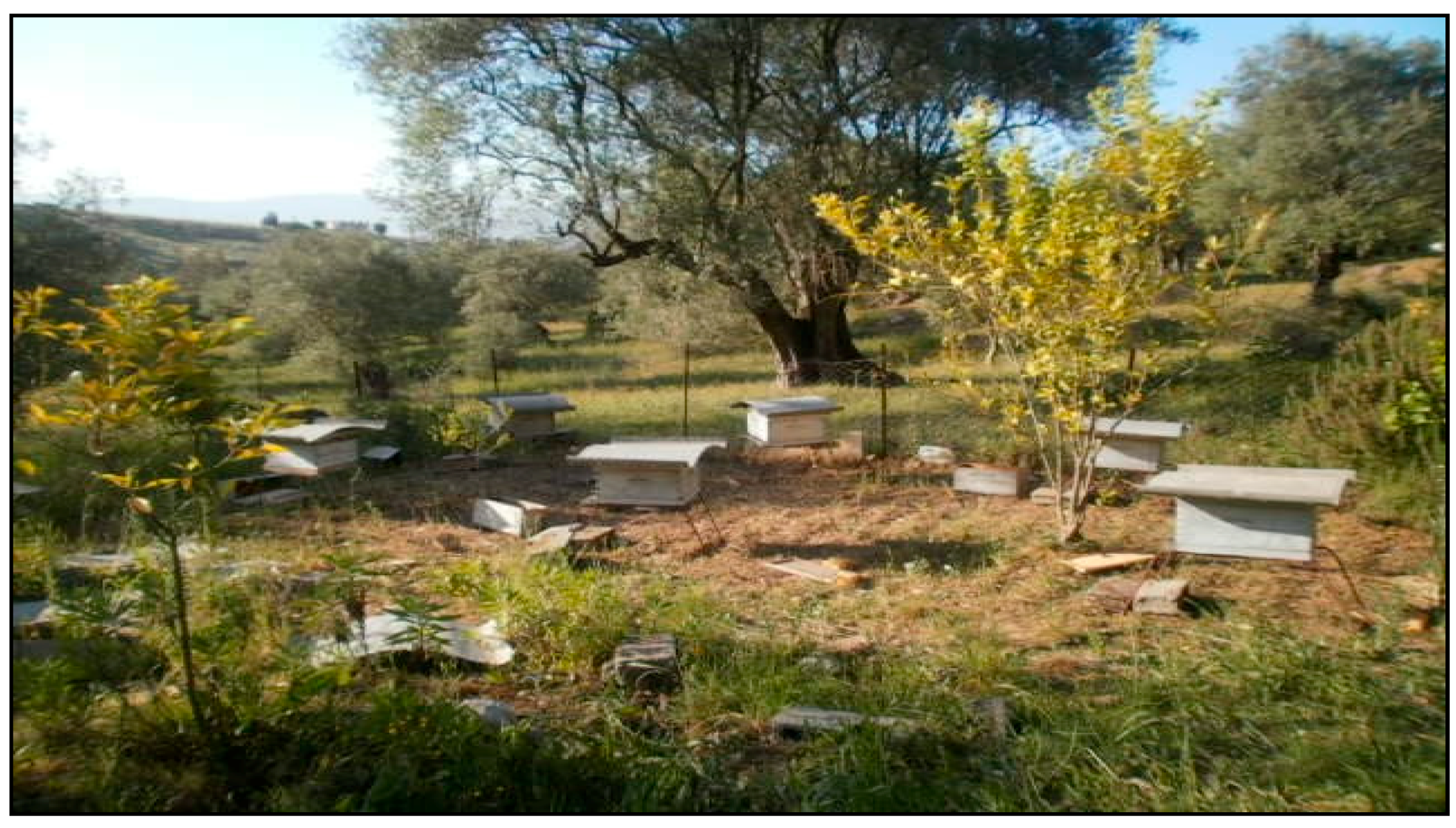
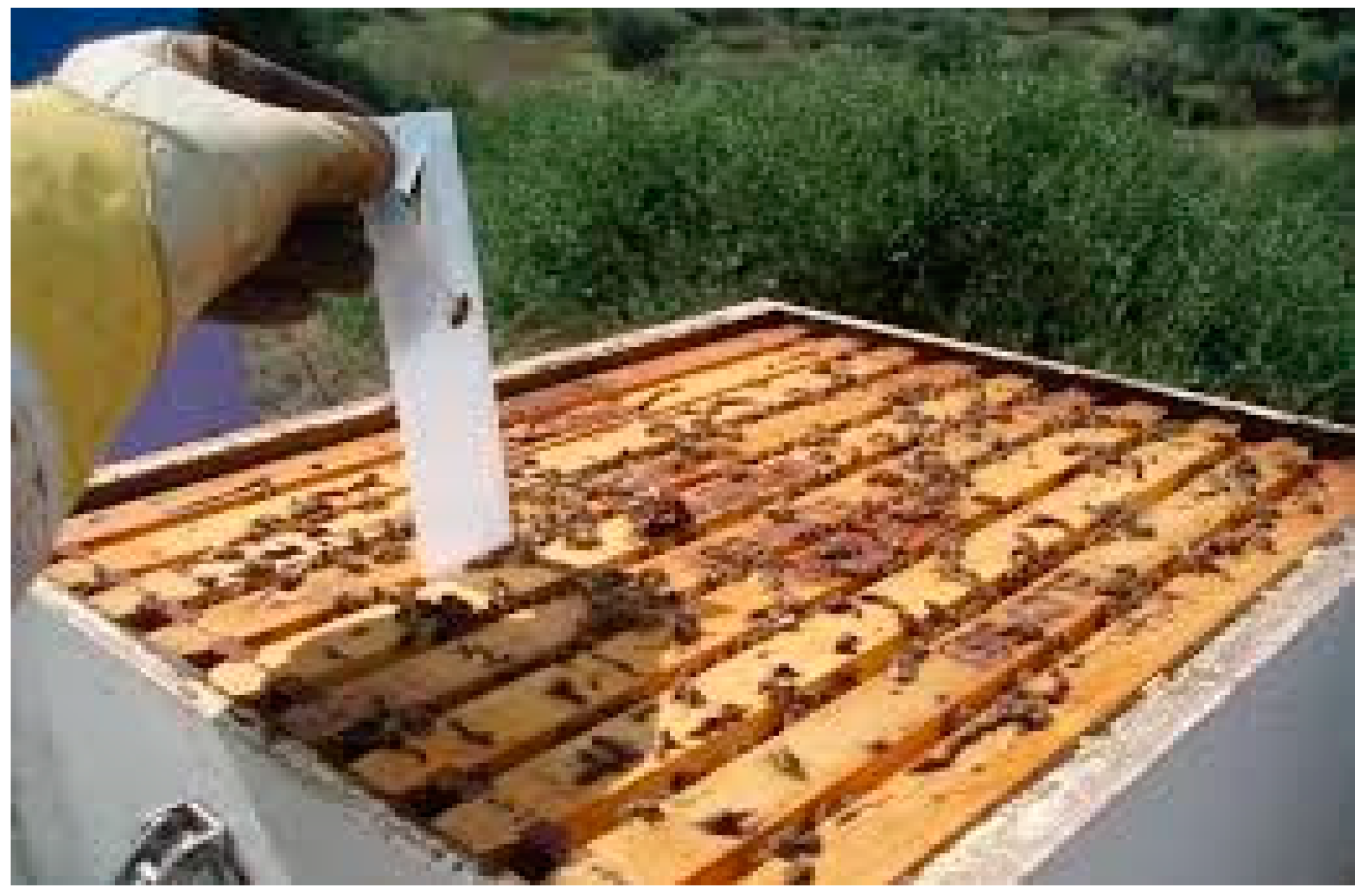
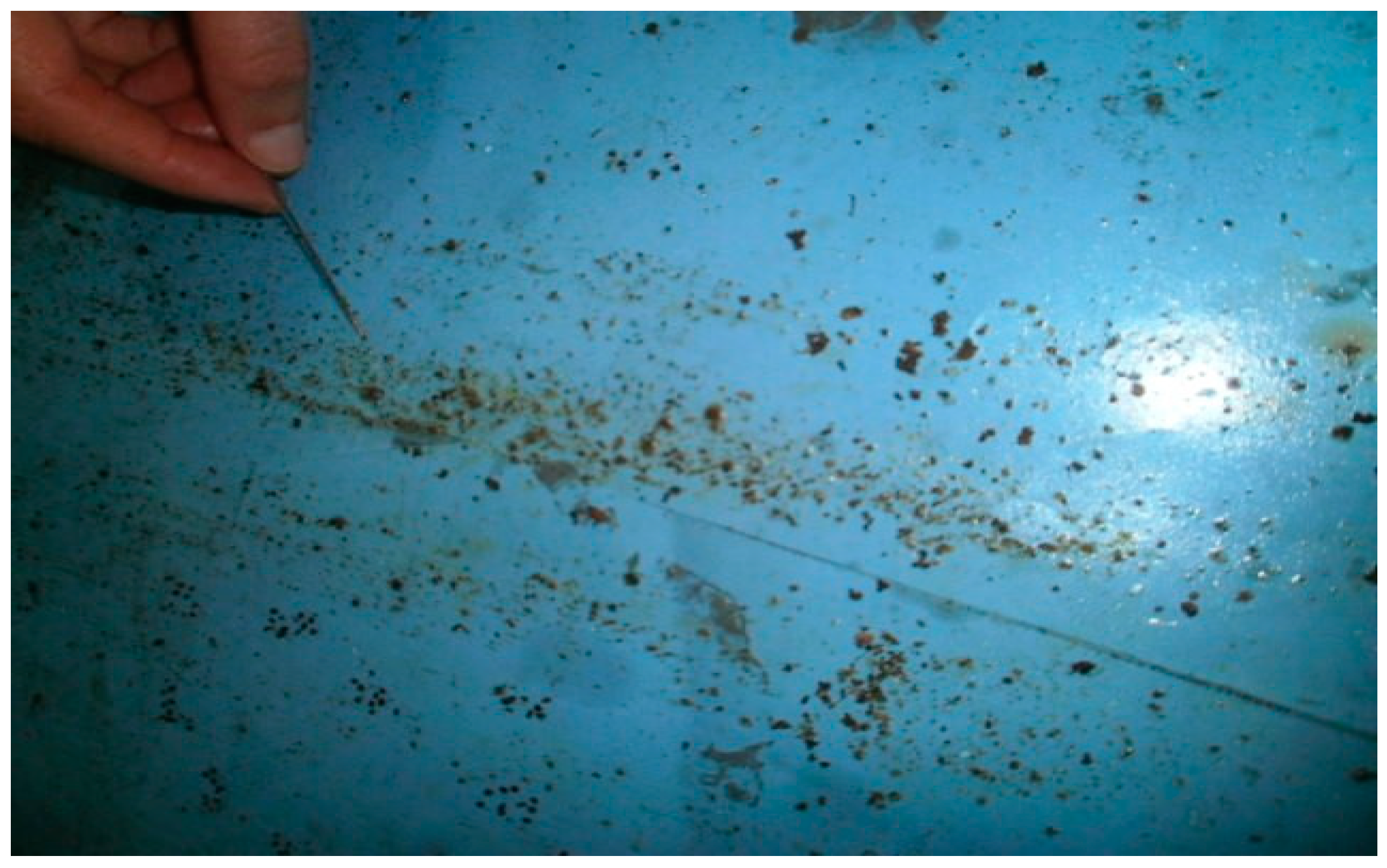
| Hive Number | Number of VARROA DIED for 01 Months “A” | Mean Mortality/d B = A/29 | Estimated Varroa Population C = B × 90 | Estimated Population Bees: P | Initial Infestation Rate TI% |
|---|---|---|---|---|---|
| Hive1 | 422 | 14.55 | 1309 | 6250 | 20.94 |
| Hive 2 | 114 | 3.93 | 354 | 8750 | 4.04 |
| Witness batch1 | 536 | 18.48 | 1663 | 15,000 | 11.087 |
| Hive 3 | 91 | 3.13 | 282 | 7500 | 3.76 |
| Hive 4 | 131 | 4.51 | 406 | 8750 | 4.64 |
| Batch2 | 222 | 7.64 | 688 | 16,250 | 4.23 |
| Hive 5 | 229 | 7.87 | 708 | 8125 | 8.71 |
| Hive 6 | 209 | 7.2 | 648 | 11,250 | 5.76 |
| Batch3 | 438 | 15.07 | 1356 | 19,375 | 6.99 |
| Hive 7 | 385 | 13.27 | 1194 | 5625 | 21.22 |
| Hive 8 | 433 | 14.93 | 1344 | 10,000 | 13.44 |
| Batch4 | 818 | 28.2 | 2538 | 15,625 | 16.24 |
| Hives treated per essential oil | 2014 | 69.39 | 6245 | 66,250 | 9.43 |
| Hive 9 | 644 | 22.2 | 1998 | 10,625 | 18.8 |
| Hive 10 | 502 | 17.31 | 1558 | 8125 | 19.18 |
| Batch5 | 1146 | 39.51 | 3556 | 18,750 | 18.96 |
| Batch chemically treated | 1146 | 39.51 | 3556 | 18,750 | 18.97 |
| global apiary (10 hives) | 3160 | 108.9 | 9801 | 85,000 | 11.53 |
| Hive | Infestation Rate after tr: TI% |
|---|---|
| Witness batch1 | 26.4 |
| Batch2 | 6.09 |
| Batch3 | 2.32 |
| Batch4 | 0.9 |
| Hives treated/Essential oil | 10.46 |
| Chemically treated batch | 9.97 |
© 2018 by the authors. Licensee MDPI, Basel, Switzerland. This article is an open access article distributed under the terms and conditions of the Creative Commons Attribution (CC BY) license (http://creativecommons.org/licenses/by/4.0/).
Share and Cite
Bendifallah, L.; Belguendouz, R.; Hamoudi, L.; Arab, K. Biological Activity of the Salvia officinalis L. (Lamiaceae) Essential Oil on Varroa destructor Infested Honeybees. Plants 2018, 7, 44. https://doi.org/10.3390/plants7020044
Bendifallah L, Belguendouz R, Hamoudi L, Arab K. Biological Activity of the Salvia officinalis L. (Lamiaceae) Essential Oil on Varroa destructor Infested Honeybees. Plants. 2018; 7(2):44. https://doi.org/10.3390/plants7020044
Chicago/Turabian StyleBendifallah, Leila, Rachida Belguendouz, Latifa Hamoudi, and Karim Arab. 2018. "Biological Activity of the Salvia officinalis L. (Lamiaceae) Essential Oil on Varroa destructor Infested Honeybees" Plants 7, no. 2: 44. https://doi.org/10.3390/plants7020044
APA StyleBendifallah, L., Belguendouz, R., Hamoudi, L., & Arab, K. (2018). Biological Activity of the Salvia officinalis L. (Lamiaceae) Essential Oil on Varroa destructor Infested Honeybees. Plants, 7(2), 44. https://doi.org/10.3390/plants7020044




